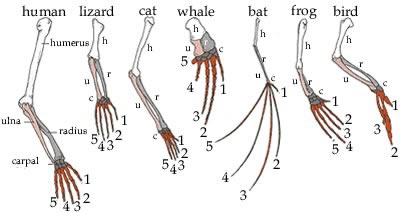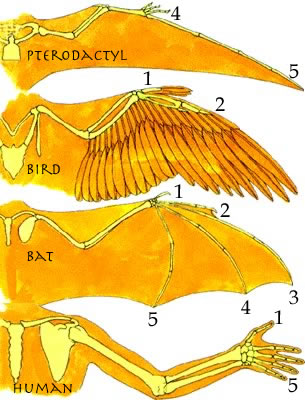| Ancestors, analogies and homologies |
|
|
|
The idea of evolution, together with the absence of spontaneous generation in the modern world leads to some simple conclusions. Given the similarities between all living organisms, which will be described below, an obvious conclusion is that all life is descended from a single common ancestor. |
|
|
|
|
|
In this scheme, each organism has a unique genus and a species name, such as Sahelanthropus tchadensi (both are italicized and the species name is not capitalized). The organism is also placed in the classification hierarchy. So Sahelanthropus tchadensi has been placed in the Kingdom of Animals, the Phylum of Chordates, the Class Mammalia, and the Order Primate (as are human beings!) |
|
|
|
Homology and Analogy A
major problem in
classifying organisms is deciding whether similar traits reflect common
ancestry or independent solutions to a particular problem, that is whether
the traits were developed independently.
|
|
For example, an anatomical analysis of the forelimb of the mammals suggests that they are homologous structures. To say that two structures are homologous means that they are derived from a common ancestor. |
 |
|
Moreover, it implies that the features they share were already present in their common ancestor. This type of reasoning leads to the prediction that fossils of the last common ancestor of the mammals will be found to have a forelimb with a similar structure to that of modern mammals. The alternative is that the structures are analogous, rather than homologous. When two structures are analogous, it means that they evolved independently. Their final form is determined by their function. |
|
|
 |
Consider the wing of a pterodactyl, a flying reptile, a bird, and a bat, a mammal. Analysis of these structures indicates that they are distinct. In the pterodactyl, the wing membrane is supported by the 5th finger of the forelimb, in the bird by the 2nd finger, and in the bat, by the 3rd, 4th and 5th fingers. The last common ancestor of flying reptiles, birds and mammals did not have wings, although it certainly had a forelimb. These structures formed independently. They are analogous structures. |
|
Under these conditions different populations will, through the process of variation and selection, end up with similar solutions. This process is known as convergent evolution. |
|
|
|
Convergent evolution occurs frequently, primarily because there are only certain solutions available to solve specific 'problems'. For example, the use of a dagger is a particularly effective solution to the problem of killing another organism. |
|
This solution has been "discovered" independently many times.
|
|
|
|
|
|
The evidence for a common ancestor: Similar structures may arise independently. Apparently different structures, such as a human hand and a whale's flipper, can be related. To distinguish between these two possibilities requires a carefully examination of structural details. The more details two structures share, the more likely they are homologous rather than analogous. |
|
|
| It is this type of careful and detailed analysis that leads us to define those features shared by all organisms. |
|
For examples, all organisms use ribosomes to translate the information stored in nucleic acids into proteins. The ribosomes of bacteria and humans are quite similar in shape and molecular organization. |
 |
 |
|
|
| All organisms share very similar biochemical pathways. Glycolysis, the break down of sugars to release energy, is present in all organisms examined to date. |
| Organisms that use oxygen share a specific cycle of chemical reactions, known as Kreb's cycle or the citric acid cycle. |
|
Based on
molecular similarities between the biochemical details of glycolysis and
citric acid cycles in various organisms we can be reasonably sure that
these metabolic pathways were present in, and
inherited from, a common ancestor. |
|
|
|
Detailed analyses of many different types of organisms reveals the presence of a common 'molecular signature' that speaks to the nature of the last common ancestor. If we look at living organisms we find they all ...
|
|
We conclude
that these features, as well as a number of others, were present in the
last common ancestor of earthly life. |
|
|
|
Check
the NCBI BookShelf | 19 October 2002
|